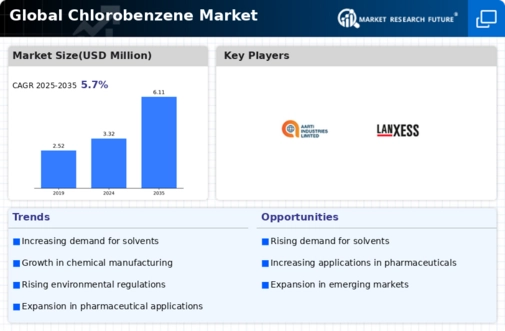Market Trends and Growth Projections
The Global Chlorobenzene Market Industry is characterized by various trends and growth projections that indicate a dynamic landscape. The market is expected to reach a valuation of 3.32 USD Billion in 2024, with a compound annual growth rate of 5.7% anticipated from 2025 to 2035. This growth is driven by factors such as increasing demand from chemical manufacturing, pharmaceuticals, and agrochemicals. Additionally, technological advancements and regulatory support further enhance the market's potential. The projected market size of 6.11 USD Billion by 2035 reflects a promising future, indicating that chlorobenzene will continue to play a crucial role in diverse industrial applications.
Emerging Markets and Industrial Growth
Emerging markets are poised to drive the Global Chlorobenzene Market Industry through industrial growth and urbanization. Countries in Asia-Pacific and Latin America are experiencing rapid industrialization, leading to increased demand for chlorobenzene in various applications, including solvents and intermediates. The expansion of manufacturing sectors in these regions is expected to contribute significantly to the market's growth trajectory. As urban populations rise, the need for consumer goods and industrial products will likely escalate, further propelling chlorobenzene consumption. This trend aligns with the overall market projections, indicating a robust future for the Global Chlorobenzene Market Industry.
Regulatory Support for Chemical Safety
Regulatory support for chemical safety significantly impacts the Global Chlorobenzene Market Industry. Governments worldwide are increasingly implementing stringent regulations to ensure the safe handling and use of chemicals, including chlorobenzene. This regulatory framework encourages manufacturers to adopt safer practices and invest in research and development for safer alternatives. Compliance with these regulations not only enhances product safety but also fosters consumer confidence in chlorobenzene applications. As a result, the market is likely to witness steady growth, as companies align their operations with regulatory expectations, thereby reinforcing the industry's stability and sustainability.
Rising Demand from Chemical Manufacturing
The Global Chlorobenzene Market Industry experiences heightened demand driven by its extensive application in chemical manufacturing. Chlorobenzene serves as a precursor for various chemicals, including phenol and aniline, which are integral to producing plastics, resins, and pharmaceuticals. As the global chemical industry expands, particularly in developing regions, the need for chlorobenzene is projected to increase. This trend is underscored by the market's anticipated growth, with a valuation of 3.32 USD Billion in 2024, reflecting a robust foundation for future expansion. The ongoing industrialization in emerging economies further supports this demand, suggesting a sustained upward trajectory for the Global Chlorobenzene Market Industry.
Growth in Pharmaceuticals and Agrochemicals
The Global Chlorobenzene Market Industry is significantly influenced by the growth in pharmaceuticals and agrochemicals. Chlorobenzene is utilized in the synthesis of various pharmaceutical compounds and agrochemical products, which are essential for modern agriculture and healthcare. As global populations increase, the demand for effective agricultural solutions and innovative pharmaceuticals rises, thereby driving chlorobenzene consumption. This sector is expected to contribute substantially to the market's growth, with projections indicating a market size of 6.11 USD Billion by 2035. The ongoing advancements in drug development and agricultural practices further enhance the relevance of chlorobenzene in these critical industries.
Technological Advancements in Production Processes
Technological advancements in production processes play a pivotal role in shaping the Global Chlorobenzene Market Industry. Innovations in manufacturing techniques enhance efficiency, reduce waste, and lower production costs, making chlorobenzene more accessible to various industries. The adoption of green chemistry principles and sustainable practices is likely to improve the environmental footprint of chlorobenzene production. As companies strive to meet regulatory standards and consumer expectations, these advancements may lead to increased market penetration. The anticipated compound annual growth rate of 5.7% from 2025 to 2035 indicates a promising outlook for the industry, driven by these technological improvements.












